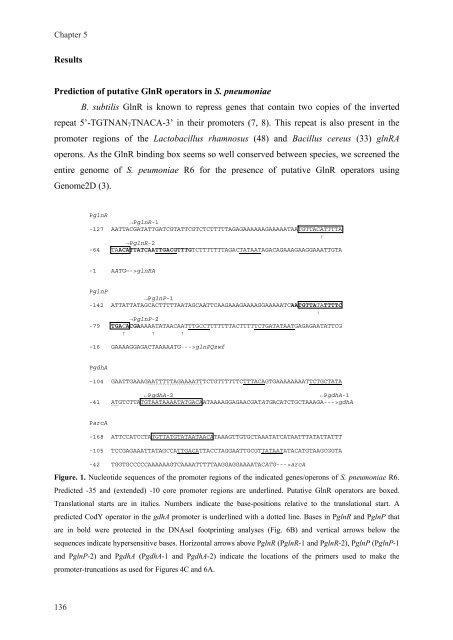Gene regulation in Streptococcus pneumoniae - RePub - Erasmus ...
Gene regulation in Streptococcus pneumoniae - RePub - Erasmus ...
Gene regulation in Streptococcus pneumoniae - RePub - Erasmus ...
Create successful ePaper yourself
Turn your PDF publications into a flip-book with our unique Google optimized e-Paper software.
Chapter 5<br />
Results<br />
Prediction of putative GlnR operators <strong>in</strong> S. <strong>pneumoniae</strong><br />
B. subtilis GlnR is known to repress genes that conta<strong>in</strong> two copies of the <strong>in</strong>verted<br />
repeat 5’-TGTNAN7TNACA-3’ <strong>in</strong> their promoters (7, 8). This repeat is also present <strong>in</strong> the<br />
promoter regions of the Lactobacillus rhamnosus (48) and Bacillus cereus (33) glnRA<br />
operons. As the GlnR b<strong>in</strong>d<strong>in</strong>g box seems so well conserved between species, we screened the<br />
entire genome of S. peumoniae R6 for the presence of putative GlnR operators us<strong>in</strong>g<br />
Genome2D (3).<br />
-42 TGGTGCCCCCAAAAAAGTCAAAATTTTTAAGGAGGAAAATACATG--->arcA<br />
Figure. 1. Nucleotide sequences of the promoter regions of the <strong>in</strong>dicated genes/operons of S. <strong>pneumoniae</strong> R6.<br />
Predicted -35 and (extended) -10 core promoter regions are underl<strong>in</strong>ed. Putative GlnR operators are boxed.<br />
Translational starts are <strong>in</strong> italics. Numbers <strong>in</strong>dicate the base-positions relative to the translational start. A<br />
predicted CodY operator <strong>in</strong> the gdhA promoter is underl<strong>in</strong>ed with a dotted l<strong>in</strong>e. Bases <strong>in</strong> PglnR and PglnP that<br />
are <strong>in</strong> bold were protected <strong>in</strong> the DNAseI footpr<strong>in</strong>t<strong>in</strong>g analyses (Fig. 6B) and vertical arrows below the<br />
sequences <strong>in</strong>dicate hypersensitive bases. Horizontal arrows above PglnR (PglnR-1 and PglnR-2), PglnP (PglnP-1<br />
and PglnP-2) and PgdhA (PgdhA-1 and PgdhA-2) <strong>in</strong>dicate the locations of the primers used to make the<br />
promoter-truncations as used for Figures 4C and 6A.<br />
136<br />
136<br />
PglnR<br />
→PglnR-1<br />
-127 AATTACGATATTGATCGTATTCGTCTCTTTTTAGAGAAAAAAGAAAAATAATGTTACATTTTA<br />
↑<br />
→PglnR-2<br />
-64 TAACATTATCAATTGACGTTTGTCTTTTTTTAGACTATAATAGACAGAAAGAAGGAAATTGTA<br />
-1 AATG—->glnRA<br />
PglnP<br />
→PglnP-1<br />
-142 ATTATTATAGCACTTTTTAATAGCAATTCAAGAAAGAAAAGGAAAAATCAATGTTATATTTTC<br />
↑<br />
→PglnP-2<br />
-79 TGACACGAAAAATATAACAATTTGCCTTTTTTTACTTTTTCTGATATAATGAGAGAATATTCG<br />
↑ ↑ ↑<br />
-16 GAAAAGGAGACTAAAAATG--->glnPQzwf<br />
PgdhA<br />
-104 GAATTGAAAGAATTTTTAGAAAATTTCTGTTTTTTCTTTACAGTGAAAAAAAATTCTGCTATA<br />
←PgdhA-2 ←PgdhA-1<br />
-41 ATGTCTTATGTAATAAAATATGACAATAAAAGGAGAACGATATGACATCTGCTAAAGA--->gdhA<br />
ParcA<br />
-168 ATTCCATCCTATGTTATGTATAATAACATAAAGTTGTGCTAAATATCATAATTTATATTATTT<br />
-105 TCCGAGAAATTATAGCCATTGACATTACCTAGGAATTGCGTTATAATATACATGTAAGCGGTA

















